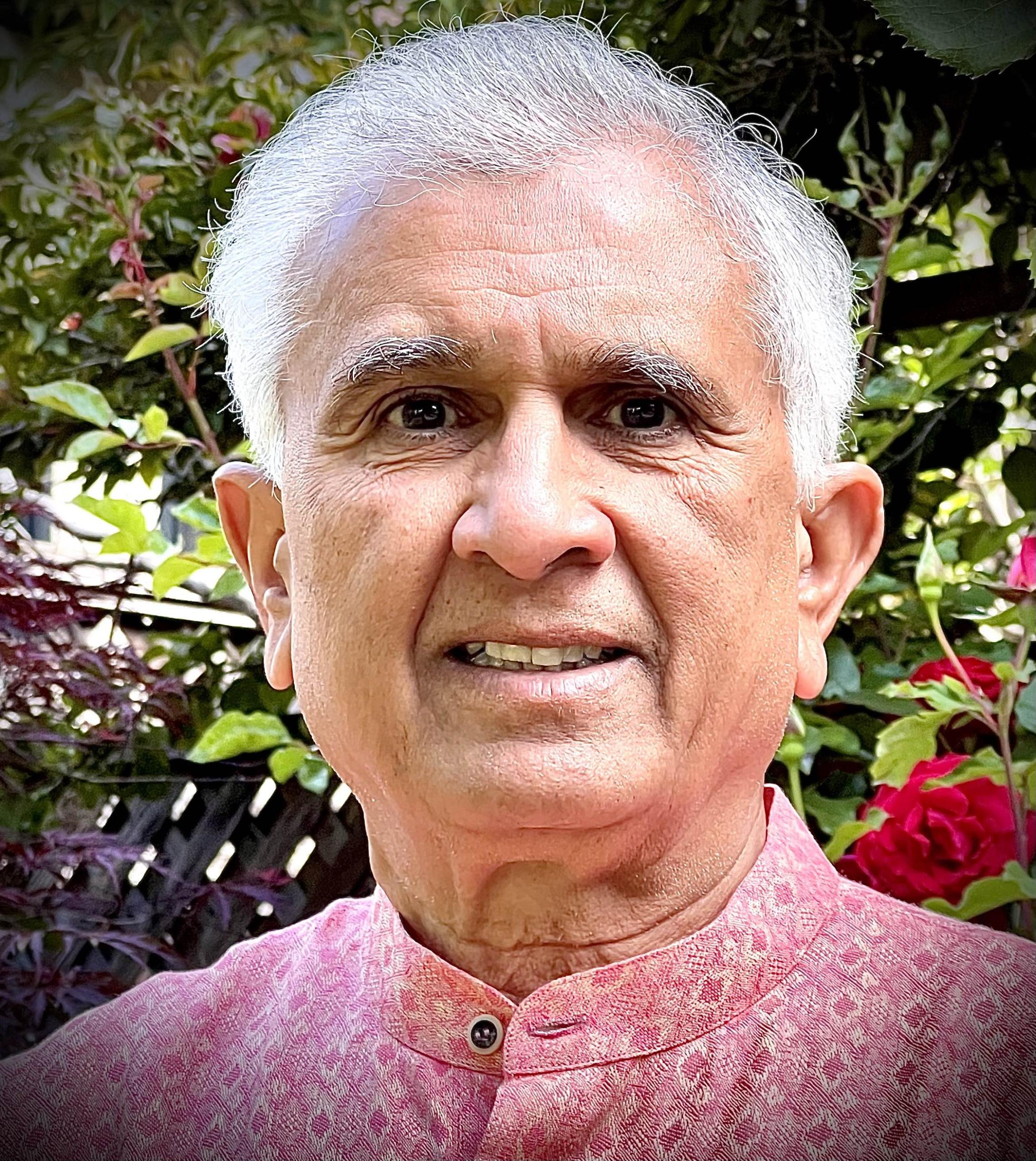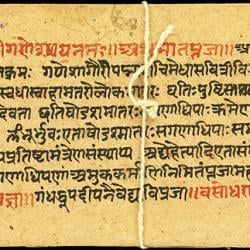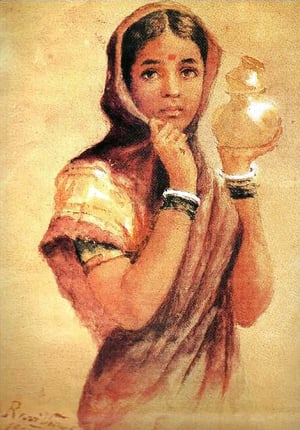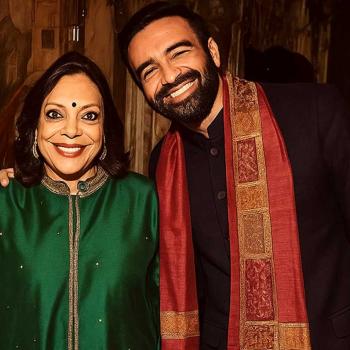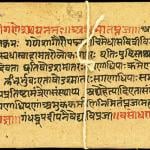 Using freedom of interfaith marriage as an indicator of religious pluralism, this study reveals that 99% of legal restrictions on interfaith unions are imposed by Islamic countries. Specifically, 32 out of 53 Muslim-majority countries (60.4%) enforce Sharia-based legal restrictions that prevent Muslims from marrying outside their faith. These laws impact an estimated 1.11 billion Muslims.
Using freedom of interfaith marriage as an indicator of religious pluralism, this study reveals that 99% of legal restrictions on interfaith unions are imposed by Islamic countries. Specifically, 32 out of 53 Muslim-majority countries (60.4%) enforce Sharia-based legal restrictions that prevent Muslims from marrying outside their faith. These laws impact an estimated 1.11 billion Muslims.
In contrast, only one Christian-majority country (out of 122; Vatican City), one Jewish-majority country (Israel), and none of the 14 Dharmic-majority countries have comparable constitutional or legal restrictions on interfaith marriage.
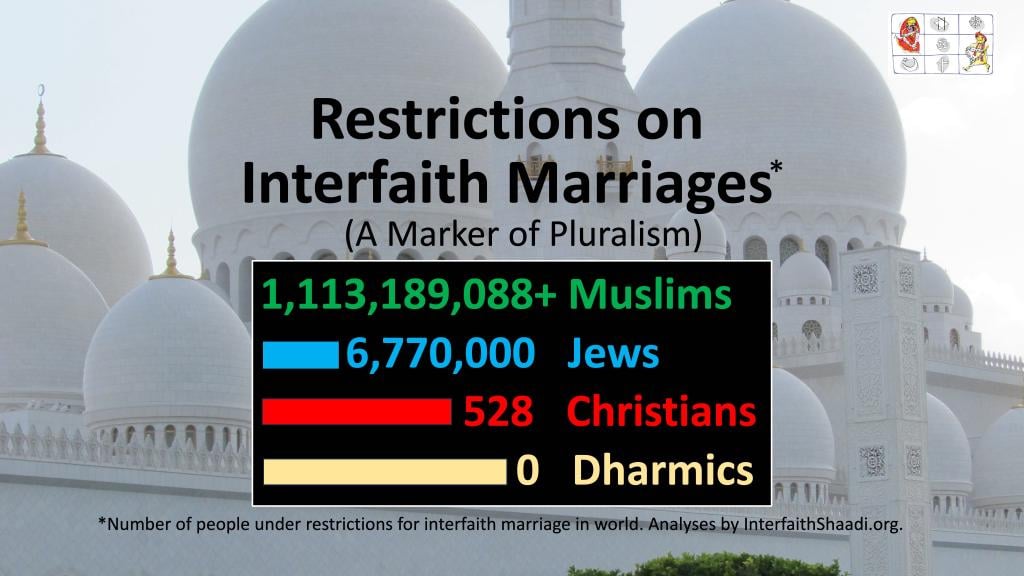
While religious institutions may set internal guidelines for their members (e.g., churches or mosques), and communities or individuals may choose to follow religious guidance voluntarily, these situations differ fundamentally from a nation codifying religious doctrines into its legal system.
This study focuses exclusively on state-imposed legal restrictions on interfaith marriage to understand the pluralistic mindset of their majority population.
High-Level New Findings
Data from Hiddush and Houssain Kettani were merged and analyzed to evaluate restrictions on interfaith marriage (IFM) imposed by various countries on the majority of their citizens.
Key Findings:
- Severe legal restrictions on IFM exist in:
- 32 Muslim-majority countries (60.4% of the 53 such countries),
- One Jewish-majority country (Israel), and
- One Christian Church-state (Vatican City).
- The number of people affected by these restrictions includes:
- 1,113,189,088+ Muslims,
- 6,770,000 Jews in Israel,
- 528 Christians in Vatican City, and
- 0 Dharmics
- The figure for Muslims (1.11 billion) is an underestimate, as it excludes Muslims living under Sharia-based restrictions in non-Muslim-majority countries (e.g., Ghana).
- Globally, 99.4% of people living under state-imposed interfaith marriage restrictions are Muslims.
- Of the 1.57 billion Muslims in all 53 Muslim-majority countries:
- 71.1% (1.11 billion) live in countries with strict legal restrictions on IFM.
- 21 countries (39.6% of the 53) offer full legal freedom for IFM, despite having an average Muslim population of 86.1%.
- By contrast:
- 121 out of 122 Christian-majority countries, and
- All 14 Dharmic-majority countries
provide freedom of interfaith marriage to their citizens—including to their Muslim minorities.
- Using interfaith marriages as a marker, this study clearly delineates where pluralism exists and where it does not.
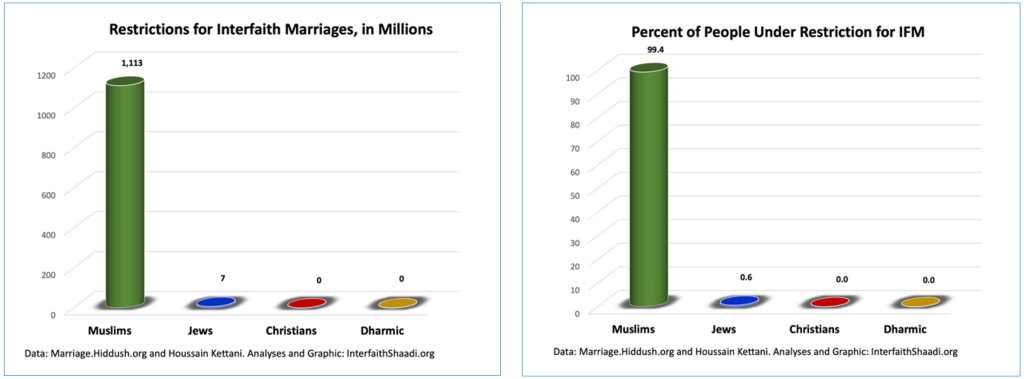
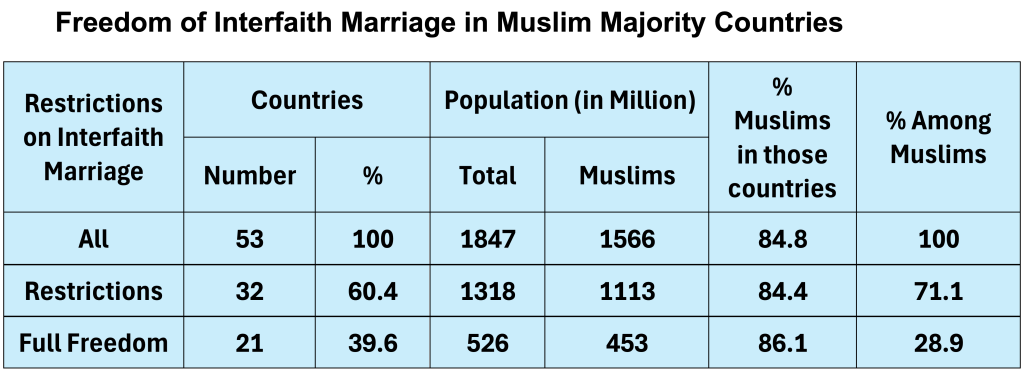
Note: This survey focuses solely on state-imposed legal restrictions. It does not address internal religious or community practices. For example:
- A Catholic church may set internal rules for its members.
- A Muslim in India may choose to follow the Sharia based Muslim Marriage Act of 1937.
These are voluntary or institutional choices—not national legal mandates—and are therefore excluded from this analysis.
Source of Data
The analysis in this study is based on two primary sources:
- Hiddush – We used the downloadable dataset provided by Hiddush on global Freedom of Marriage. To avoid introducing any personal or interpretive bias, we relied strictly on the descriptions and classifications provided by Hiddush, without altering or reinterpreting their criteria.
- Houssain Kettani – Population data was drawn from Kettani’s demographic work, primarily using figures from 2020 or the closest available year. In keeping with our goal of neutrality, we deliberately avoided using more recent population estimates selectively for specific countries.
In a few instances, additional data sources were used to fill specific gaps. These instances are individually cited where applicable.
Method of Data Analysis
The author utilized the Hiddush dataset to evaluate global restrictions on freedom of interfaith marriage and merged it with population data from Houssain Kettani for demographic analysis.
From Hiddush’s broader category of “restrictions on marriage,” we excluded non-relevant factors such as:
- Gender discrimination,
- Underage marriage,
- Caste-based restrictions,
- Forced marriage,
- Polygamy,
- LGBTQ+ rights, and
- Kidnapping.
We retained only those countries that explicitly impose legal restrictions on interfaith marriage.
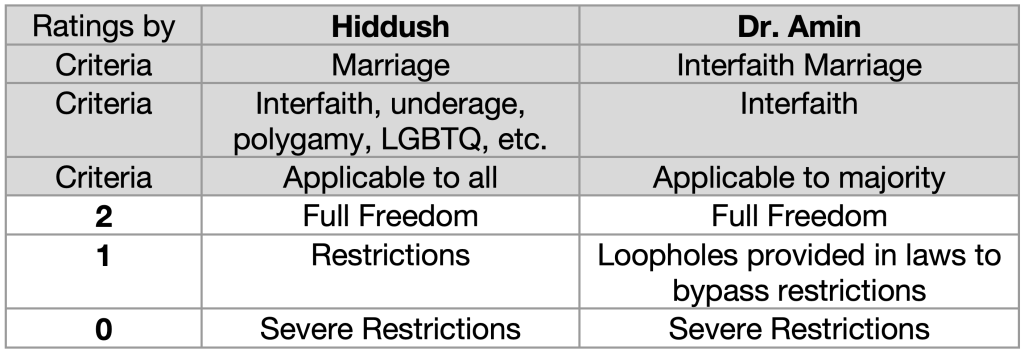
Example – Ghana
Ghana is a Christian-majority country, but its Muslim minority may be subject to Sharia-based marriage laws, potentially limiting their freedom of IFM. However, for the purposes of this study, Ghana was categorized as Category 2 (Freedom of IFM) because our methodology is based solely on the legal freedom available to the majority population of a country.
This approach implies that the actual number of Muslims globally under IFM restrictions is higher than the 1.11 billion estimated. However, due to a lack of reliable quantitative data on populations governed by Sharia law in non-Muslim-majority nations, further analysis on this subset was not pursued.
Example – Israel
In Israel, only religious weddings conducted under Orthodox Jewish law are officially recognized for the majority Jewish population. However, the Ministry of Interior accepts civil marriages performed abroad, providing a relatively accessible workaround. Technically, Israel may fall under Category 1 (Restrictions), but for the sake of consistency and simplicity, we have categorized Israel as Category 0 (Severe Restrictions) throughout most of this report.
Why There Is a Need to Generate This Information
There are two primary reasons motivating this analysis:
- Evaluating Claims of Religious Freedom and Pluralism
Many religious leaders, especially in interfaith forums, assert that their faith imposes no compulsion in religion (e.g., Quran 2:256) and that believers enjoy full freedom to follow—or not follow—their religion and make independent life choices. While such statements are often made in good faith, they remain subjective and difficult to verify across different cultures and legal systems.
To bring objectivity to this discussion, this study relies on measurable legal data—specifically, civil laws governing interfaith marriage—as an indicator of actual religious freedom and pluralism within a society. This approach allows for a comparative, data-driven assessment across religions.
- Reinterpreting Hiddush Data with a Narrower Focus
Hiddush has previously published valuable data on “Freedom of Marriage” across nations. Their scoring system (Categories 0 to 2) accounts for a broad range of issues such as Interfaith marriages, gender discrimination, underage marriage, polygamy, LGBTQ+ rights, etc.
While comprehensive, this wide scope sometimes obscures the specific issue of “Freedom in Interfaith Marriage.” To address this gap, the author reclassified Hiddush’s data with a singular focus: freedom of interfaith marriage available to the majority population of each country.
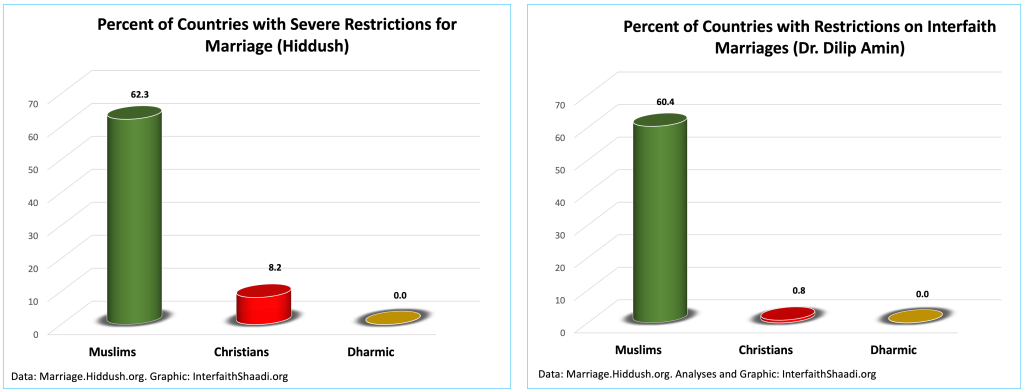
In Hiddush’s original dataset, marriage restrictions were reported in:
- 33 out of 53 Muslim-majority countries (62.3%),
- 1 out of 1 Jewish-majority country,
- 10 out of 122 Christian-majority countries (8.2%), and
- 0 out of 14 Dharmic-majority countries (Hindu and Buddhist).
However, upon closer examination, it became clear that among Christian-majority countries, only the Vatican City State imposes legal restrictions on interfaith marriage. This discrepancy between general marriage restrictions and interfaith-specific restrictions necessitated the need for a new, more targeted analysis.
Example — India
According to Hiddush, India is classified under Category 1, citing issues such as underage and forced marriages, as well as caste-based discrimination. Their summary reads:
“Formal freedom of marriage. There are reports of underage marriage, many of them are forced marriages. There are reports of discrimination practiced, based on caste.”
However, for the purpose of this study, India is reclassified under Category 2 (Full Freedom) because it offers formal legal freedom of interfaith marriage to all citizens, including Muslims and other minorities.
Jewish-Majority Country (n = 1): Israel
In the Hiddush dataset, Israel—the world’s only Jewish-majority country—is classified under Category 0 (Severe Restrictions on Marriage). Hiddush provides the following explanation:
“Only recognized religious marriage ceremonies are allowed. For Jews, only weddings that are held according to strict Orthodox standards are accepted. There is no option for civil marriage or interfaith marriage. Weddings conducted outside of the country are recognized. 300,000 citizens are defined as ‘without religion’ and they are unable to get married in the country.”
In the author’s earlier 2017 publication, the legal framework in Israel was summarized as follows:
“Israeli law permits only religious marriages held by religious authorities and does not allow civil marriages. Among the Jewish population, the Chief Rabbinate—operating according to Orthodox Jewish standards—holds a monopoly over marriage. Only those recognized as Jews under Orthodox Jewish law may marry in Israel. Members of other religions may only marry within their own faith, and only through their recognized religious authority. As a result, interfaith and non-religious marriages are not permitted in Israel. However, the Ministry of Interior does register and accept civil marriages conducted abroad.”
Although these restrictions are significant, Israel does offer a practical loophole:
An Israeli in an interfaith relationship may travel abroad to marry, and upon return, can register the marriage with the Ministry of Interior. This makes it relatively straightforward for interfaith couples to gain legal marital status—despite the domestic ban.
By contrast, most Muslim-majority countries offer no such legal workaround. For example, the author previously wrote about Malaysia:
“A marriage registered under the laws of a foreign country must be re-registered at the Malaysian Representative Office within six months of the date of marriage. An interfaith couple married outside Malaysia will not be able to register their matrimonial status in Malaysia, and their children will be denied the benefit of Malaysian citizenship.”
This key difference underscores that, while Israel legally restricts interfaith marriage, the practical impact is partially mitigated by its recognition of foreign civil marriages—a privilege generally not afforded in Sharia-enforcing Muslim-majority nations.
Christian-Majority Countries (n = 122)
According to Hiddush, 10 Christian-majority countries were categorized under Category 0 (Severe Restrictions on Marriage). However, upon further examination, the author determined that only Vatican City truly imposes severe restrictions specifically on interfaith marriages. The other nine were reassessed and reclassified as Category 2 (Freedom of IFM), based on the criteria used in this analysis.
Vatican City State
- Hiddush classification: Category 0
- Hiddush comment: “Marriage in the Vatican is only available for Catholics.”
- Author: Vatican City, the smallest sovereign nation (0.49 square kilometers), has a population of only 528, largely comprised of Catholic Church clergy and staff. Given that civil marriages are not recognized and only Catholics can marry within the state, the author maintains Hiddush’s categorization of Category 0, as Catholics residing there have no option for IFM.
Other Nine Countries Initially Labeled Category 0 by Hiddush – Reclassified as Category 2 (Freedom of IFM)
Although these countries were placed in Category 0 by Hiddush due to various social or cultural concerns (e.g., polygamy, underage marriage, discrimination against women), none of them legally prohibit interfaith marriage for the majority Christian population. Hence, they are reclassified as Category 2 for this study.
- Cameroon
Hiddush: “Formal freedom of marriage. The legal age for marriage is 15. According to reports in the northern areas of Cameroon, marriages at even younger ages are a common occurrence. Young girls are often sent away from home to marry older men.” - Central African Republic
Hiddush: “Formal freedom of marriage. According to reports, there is a large amount of women between the ages of 15-19 that are married, divorced, or widowed. Polygamy is legal.” - Congo-Kinshasa (Democratic Republic of the Congo)
Hiddush: “Marriage laws discriminate negatively against women. There are many reports of women who have been raped and because of that, are unable to get married. There are also many reports of selling women for marriage.”
Author’s note: In rural areas, unofficial Islamic (Sharia) courts sometimes operate. However, these do not override the freedom of interfaith marriage for the Christian majority. - Ethiopia
Hiddush: “Formal freedom of marriage. There are reports of specific discrimination towards women and frequent occurrences of underage and forced marriages.” - Ghana
Hiddush: “There are three parallel types of marriage law: Civil marriage, traditional marriage, and Islamic marriage according to Sharia law. According to reports, there are many forced marriages and marriages of minors through traditional and sharia law.”
Author: Christian citizens have full legal freedom to marry interfaith, thus the country is classified as Category 2. - Kenya
Hiddush: “There are options to hold marriage ceremonies according to traditional and Islamic laws that reportedly discriminate against women. A quarter of women in Kenya are married as girls.” - Papua New Guinea
Hiddush: “There are options for both civil and traditional marriages. According to reports, here is a growing trend of underage marriages and polygamy.” - Tanzania
Hiddush: “There are reports of marriages being held at a young age and the law in Tanzania permits polygamy.” - Togo
Hiddush: “Formal freedom of marriage. There are reports of discrimination against women in traditional marriages. There are also reports of underage marriages and polygamy amongst significant percentages of the population.”
Despite these concerns, none of these countries place legal restrictions on interfaith marriage for their majority Christian populations, which justifies their reclassification under Category 2.
Hiddush Category 1 Countries – Author’s Reclassification
Hiddush placed 30 Christian-majority countries in Category 1 (Some Restrictions on Marriage) due to societal practices or religious minority laws (e.g., Sharia law applied to Muslim citizens). However, since this analysis is focused on freedom of interfaith marriage for the majority religion (Christianity), these countries are reclassified as Category 2.
Two illustrative examples:
- Philippines
Hiddush: “Formal freedom of marriage. The marriage laws for the small Muslim population is ruled by the Sharia. There are reports of young girls who are forced into marriages, especially in the Muslim sector.”
Author: Christian citizens face no legal barriers to interfaith marriage. - Trinidad and Tobago
Hiddush: “Formal freedom of marriage. The minimum legal age for marriage depends on religion. For example, in Muslim weddings (held according to Sharia law) the minimum age is 12.”
Author: Christians are free to marry interfaith, hence reclassified to Category 2.
The full list of Category 1 countries can be referenced in the Hiddush report.
Dharmic-Majority Countries (n = 14)
The 14 countries with a majority population following Dharmic faiths (Hinduism, Buddh.ism, Jainism, and Sikhism) include:
Bhutan, Cambodia, India, Japan, Laos, Mauritius, Mongolia, Myanmar (Burma), Nepal, Singapore, Sri Lanka, Taiwan, Thailand, and Vietnam.
According to both Hiddush and this analysis, all 14 Dharmic-majority countries provide formal freedom of interfaith marriage for people of all religions. These countries are consistently categorized as Category 2 (Freedom of IFM).
To illustrate the legal framework, the following example is provided:
Marriage Laws in India
India exemplifies a pluralistic legal system that accommodates the country’s religious diversity through both personal laws and civil marriage laws.
- Dual System of Marriage Laws:
Each religious community is governed by its own set of personal laws. However, individuals may opt out of these community-specific laws and instead marry under civil law via the Special Marriage Act, 1954, which enables interfaith marriages without religious conversion. - Personal Law Framework:
- Hindus (including Jains, Sikhs, and Buddhists) – governed by the Hindu Marriage Act, 1955.
- Muslims – governed by the Muslim Personal Law (Shariat) Application Act, 1937.
- Christians – governed by the Indian Christian Marriage Act, 1872.
- Parsees (Zoroastrians) – governed by the Parsee Marriage & Divorce Act, 1936.
- Special Marriage Act, 1954:
This act provides a secular legal framework that allows any two persons, regardless of religious background, to marry without conversion. The marriage is registered under civil law and governed by secular provisions.
This pluralistic approach ensures that freedom of interfaith marriage is legally protected in India, consistent with the categorizations by both Hiddush and the author.
Muslim-Majority Countries (n = 53)
Muslim-majority countries exhibit the greatest legal restrictions on interfaith marriages. Based on Hiddush and this author’s analysis, 32–33 of these 53 countries fall under Category 0 (Severe Restrictions), while only 20–21 countries have some restrictions or formal freedom for interfaith marriage.
Hiddush Category 0 – Severe Restrictions on Marriage (n = 33)
According to Hiddush, these 33 Muslim-majority countries impose severe restrictions on marriage:
Afghanistan, Algeria, Bahrain, Brunei, Burkina Faso, Chad, Comoros, Djibouti, Egypt, Eritrea, Indonesia, Iran, Iraq, Jordan, Kuwait, Lebanon, Libya, Malaysia, Maldives, Morocco, Nigeria, Oman, Pakistan, Palestinian Authority, Qatar, Saudi Arabia, Somalia, Somaliland, Sudan, Syria, Tunisia, United Arab Emirates, and Yemen.
Differences in Categorization
The author finds that three countries—Burkina Faso, Chad, and Gambia—require reclassification, based on constitutional and legal frameworks.
- Burkina Faso (60.5% Muslim)
- Hiddush: “Formal freedom of marriage. In rural areas, women are reported to be considered the property of their husbands. According to reports, one-third of girls between the ages of 15-19 are married and there are many reports of forced marriage.”
- Author: It is officially a secular state, as enshrined in its constitution, which guarantees freedom of religion and prohibits the establishment of a state religion. The country’s legal system is based on civil law, and Sharia law is not incorporated into the national legal framework.
- Chad (55.6% Muslim)
- Hiddush: “Formal freedom of marriage. The legal age for engagement is 11. There are many reports of forced marriage and selling women for marriage.”
- Author: Considering there is a secular constitution, the author classified Category 2: freedom of interfaith marriage. However, Chad allows for the application of customary and religious laws in personal matters, particularly in family law. This means that in practice, Sharia law is applied in certain contexts.
- Gambia (90.0% Muslim)
- Hiddush: Category 1 (some restrictions), “There are four parallel types of marriage law recognized in Gambia. Most of the women are married through traditional marriage law. There is no minimum age for marriage and there are many reports of forced marriage.”
- Author: Due to the Sharia-based Cadi Courts governing family law for Muslims—including interfaith issues—Gambia is reclassified as Category 0: Severe Restriction (Ref 1, Ref 2)
Selected Country Notes (Category 0)
- Malaysia & Indonesia: The author has visited and extensively documented marriage laws in both. A total of 96 advisory posts were written to help youth from these nations in interfaith relationships.
- Pakistan (96.5% Muslim)
- Hiddush: “Marriage and divorce laws are determined by Sharia. There are reports of discrimination against women and restrictions on interfaith marriage.”
- Author: Confirms severe restrictions, especially against non-Muslim men marrying Muslim women.
Category 2 – Freedom of Interfaith Marriage (n = 21)
According to Hiddush, only three countries are formally rated with freedom of marriage:
Bosnia and Herzegovina (43.8% Muslims), Kazakhstan (70.9%), and Kosovo (93.5%).
However, based on constitutional analysis, the author identifies 18 additional Muslim-majority countries with de jure freedom of IFM:
Albania, Azerbaijan, Bangladesh, Burkina Faso (see above), Chad (see above), Guinea, Guinea-Bissau, Ivory Coast, Kyrgyzstan, Mali, Mauritania, Niger, Senegal, Sierra Leone, Tajikistan, Turkey, Turkmenistan, and Uzbekistan.
Selected Country Notes (Category 2)
- Bangladesh (89.6% Muslim)
- Hiddush: “Formal religious freedom of marriage, but there are reports of forced marriages of girls at a young age.”
- Author: Legally permits interfaith marriages, but societal norms make them nearly impossible. The Hindu population declined from 28% to 7.95% over 80 years (the same numbers for Pakistan, 14.6% to 1.6%). Despite legal provision, not a single visible Hindu-Muslim couple is known publicly.
- Senegal (93.8% Muslim)
- Hiddush: “Formal freedom of marriage. Traditional marriage laws still have a large influence on marriages and polygamy is permitted. There are many reports of illegal underage marriages. In certain areas, the Sharia determines marriage law.”
- Author: A secular republic; civil law governs marriage nationally. Islamic influence exists, but Sharia is not the basis for national law.
- Turkey (99.2% Muslim)
- Hiddush: “Formal freedom of marriage. There reports of many problems, such as underage and forced marriages, especially in rural areas.”
1.11 Billion Muslims: A Very Conservative Estimate
We found that 1.11 billion Muslims—55% of the world’s 2.04 billion Muslims in 2020—live in Muslim-majority countries with severe legal restrictions on interfaith marriages. However, this figure is a very conservative estimate for several reasons.
First, we excluded some Muslim-majority countries like Chad and Senegal where national laws may appear neutral, but Sharia-based practices are allowed in certain regions, effectively limiting interfaith marriages in practice.
Second, Christian-majority countries such as Congo, Ghana, Kenya, the Philippines, and Trinidad and Tobago also permit Sharia-based restrictions for Muslim minorities, which restrict their freedom of interfaith marriage.
Third, Bangladesh is a country where the constitution does not prohibit interfaith marriages, yet in practice, not a single Hindu-Muslim married couple can be found, as the majority community is socially and culturally intolerant of such unions.
Fourth, in India, Muslims technically have the freedom to marry under secular law, but most Muslims prefer registering their marriages under the Sharia-based Muslim Personal Law (Shariat) Application Act of 1937, which prohibits interfaith unions unless the non-Muslim converts.
Collectively, considering multiple factors, Muslims under severe restrictions for interfaith marriage are far more than projected in this report.
Interfaith Marriages as a Marker of Pluralism
Many religious leaders proudly assert that their faith is pluralistic—respecting other religions and their practices. However, such claims are often difficult to quantify or compare across traditions. One meaningful and measurable test of true pluralism, the author argues, is the approach to interfaith marriage.
A genuinely pluralistic interfaith union should be based on Sharing and Respect with Equality—where both partners are free to retain and practice their respective faiths equally (ideally 50–50%). In contrast, exclusivist traditions often require the partner from another faith to convert or abandon their own religion. These traditions may also discourage, or even prohibit, the practice of both faiths within a single household.
Furthermore, in countries where exclusivist supremacist ideologies dominate, civil or religious laws are often structured to restrict or suppress interfaith marriages altogether. The findings of this research project offer a rare quantitative comparison across religions—revealing how different traditions actually perform, in practice, when it comes to pluralism in the context of interfaith unions.
Scriptures and Interfaith Marriages
All religious scriptures contain some exclusivist statements—or are often interpreted that way by followers or critics. This can be seen in the Quran, Bible, Torah, Bar Mitzvah and even sometimes in texts like the Gita.
In contrast, Dharmic traditions—such as Hinduism, Buddhism, Jainism, and Sikhism—generally do not contain explicit prohibitions against interfaith marriage. These are non-proselytizing religions and do not have a practice of religious conversion as a condition for marriage. Interfaith couples within Dharmic traditions (e.g., Hindu-Buddhist or Jain-Sikh) often retain and respect both faiths, practicing them to varying degrees within the family. The author uses this as a true marker of pluralism.
Torah, Bible and Bar Mitzvah
“Nor shall you make marriages with them. You shall not give your daughter to their son, nor take their daughter for your son.” (Deuteronomy 7:3)
“You shall not intermarry with them.” (I Kings 11:2)
“Do not give your daughters as wives for their sons, nor take their daughters to your sons; and never seek their peace or prosperity.” (Ezra 9:12)
“We would not give our daughters as wives to the peoples of the land, nor take their daughters for our sons.” (Nehemiah 10:30, 13:25)
“Judah has been unfaithful… marrying women who worship a foreign god.” (Malachi 2:11).
“She is at liberty to be married to whom she wishes, but he must belong to the Lord.” (I Corinthians 7:39)
“Do not be unequally yoked together with unbelievers.” (II Corinthians 6:14)
“Not to marry non-Jews.” (Bar Mitzvah: 162)
Quran
Quran 2:221: “You shall not wed a pagan women, unless they embrace the Faith. A believing slave-girl is better than an idolatress, although she may please you. Nor shall you wed idolaters, unless they embrace the Faith. A believing slave is better than an idolater, although he may please you.”
Quran 60:11 “Do not maintain your marriages with unbelieving women.” (The Koran, N. J. Dawood, Penguin Books, 2003)
Sharia Laws on Interfaith Marriages
Source of this section on Sharia: ChatGPT, OpenAI. Response generated on July 16, 2025, based on Quranic verses (2:221, 5:5, 60:10) and classical Islamic jurisprudence.
Sharia (Islamic law) addresses interfaith marriages in detail, with different rules for men and women. These rules are derived primarily from the Quran, Hadith (Prophet Muhammad’s sayings), and classical Islamic jurisprudence (fiqh). Here’s a summary:
- Muslim Man Marrying a Non-Muslim Woman
Permitted with restrictions:
- Allowed: A Muslim man may marry a Jewish or Christian woman (People of the Book / Ahl al-Kitab) without her converting to Islam.
- Quran 5:5 supports this.
- Not allowed: Marrying a polytheist, Hindu, Buddhist, or atheist woman is generally prohibited unless she converts to Islam.
Note: In practice, this is often discouraged in traditional Muslim societies due to concerns about children’s religious upbringing.
- Muslim Woman Marrying a Non-Muslim Man
Strictly prohibited in classical Sharia:
- A Muslim woman cannot marry any non-Muslim man (Christian, Jewish, Hindu, etc.) unless he first converts to Islam.
- This rule is based on:
- Quran 2:221: “Do not marry polytheistic men until they believe…”
- Quran 60:10: “Muslim women are not lawful for disbelievers, nor are disbelievers lawful for them.”
- Scholarly consensus (ijma) from all four Sunni schools and major Shia authorities.
This is the most restrictive and inflexible rule regarding interfaith marriages in Islam.
- Marriage Ceremony
- Nikah (Islamic marriage contract): Must follow Islamic rules. A marriage without a valid nikah may not be recognized under Sharia.
- If the marriage is interfaith but done outside Sharia compliance, it’s considered invalid or sinful (haram) in conservative interpretations.
- Children in Interfaith Marriages
- According to Sharia, children of a Muslim parent (especially a father) are automatically considered Muslim.
- This is often a source of tension in interfaith unions, especially during child custody or religious upbringing discussions.
Modern Variations
- Progressive Islamic scholars: Some advocate for allowing Muslim women to marry non-Muslim men under mutual respect and conditions.
- Secular Muslim-majority countries (like Turkey or Tunisia): May legally allow interfaith marriages, but they are often not accepted religiously.
Summary of Sharia Rules:

Author: Abrahamic scriptures are often interpreted by some as exclusivist and opposing interfaith marriages. However, others—including pluralist scholars—offer more inclusive interpretations. For example, some Muslims interpret Quran 2:221 in ways that support interfaith marriages.
While scriptures themselves are fixed texts, our understanding of them can evolve. What matters today is how we interpret these teachings in ways that are relevant, compassionate, and inclusive for contemporary society.
Christianity versus Islam
Christianity and Islam are both proselytizing religions and, historically, have been responsible for large-scale violence committed in the name of God—arguably more so than any other faiths. Despite this shared past, there is a stark difference today in how these religions handle interfaith marriages. All Christian-majority countries—except the Vatican, a unique church-state—have no legal restrictions on interfaith marriage. In contrast, about 60% of Muslim-majority countries maintain such restrictions.
To illustrate the scale of this difference:
- Christians under interfaith marriage restrictions: 528 individuals
- Muslims under interfaith marriage restrictions: 1,113,189,088+ individuals
This raises an important question: Why such a stark difference today, even though both religions contain relatively similar scriptural guidance?
The author believes the key distinction lies in the relationship between religion and the state. Over time, Christian-majority societies have largely managed to separate Church and State. This allows the majority of citizens to make personal decisions—such as whom to marry—without religious interference.
In contrast, in most Islamic countries, religion and governance remain closely intertwined. The classical Islamic view holds that the head of a Muslim state must be Muslim. While this view is widely accepted, it is not explicitly stated in the Quran. The closest verses often cited are:
- Quran 5:51 – “Believers, do not take Jews and Christians as allies; they are allies of one another.”
- Quran 4:141 – “Allah will never grant the disbelievers a way over the believers.”
There is also no hadith that directly prohibits non-Muslims from being political leaders over Muslims. However, a widely cited hadith says: “The leaders (Imams) should be from among the Quraysh” (Sahih Muslim), which has been interpreted by some as a precedent for Muslim-only leadership.
Despite the absence of explicit textual prohibitions, the theocratic model still prevails in most Muslim-majority nations. In such systems, religious authorities play a dominant role in both governance and personal law (examples: Iran, Malaysia). It is in the interest of these authorities to restrict interfaith marriages, as such restrictions effectively require the non-Muslim partner to convert to Islam—thus increasing the Muslim demographic.
It appears that large segments of the Muslim community remain complicit with this status quo, either through passive acceptance or active support.
Author’s Reflections
Restrictions on interfaith marriages are imposed almost exclusively by Muslim-majority nations. Israel, a Jewish state, has similar limitations, but it allows certain legal loopholes—such as civil marriages abroad—that provide some relief for interfaith couples. Vatican City, the only Christian theocratic state, has a population of just 528, composed primarily of church officials. In contrast, no Dharmic-majority nation has imposed restrictions on IFM.
In today’s increasingly interconnected world, people travel widely for work and education, and form new relationships through social media and global networks. As a result, approximately 40% of people from all religions now marry outside their faith. In the United States, the author has found that 38% of Dharmic individuals marry Abrahamic partners, and 45% of Muslims marry outside their faith. Interfaith relationships are growing rapidly and are projected to rise even faster in the coming decades.
While statistics are available on interfaith marriages, little is known about the number of people who attempted but failed in interfaith relationships. Having personally guided over 1,300 interfaith dating individuals, the author has observed that most face significant emotional distress and hardship—often unprepared for the institutional, societal, and legal barriers that arise. These struggles, including failed relationships, affect a growing number of youth and will have increasing social implications in the future.
Individuals have the right to choose a conservative or liberal religious outlook for their personal life, and such choices must be respected as long as they do not harm others. However, the issue becomes more complex when a nation imposes a religious (or anti-religious, as seen in China) ideology on its citizens. In interfaith relationships, restrictive laws disproportionately burden the minority-faith partner. When legal constraints favor the majority religion, the minority partner is often left with only two painful choices:
- abandon the relationship, or
- undergo a forced or fake conversion simply to comply with national law.
A third option—emigrating and marrying abroad—is rarely practical or affordable for most.
When enacting strict laws against IFM, Islamic countries (and Israel) may have considered the demographic advantage such laws create: by coercing conversion, they effectively expand the majority religious population. From a self-serving perspective, the majority faith loses nothing and potentially gains followers. It is, therefore, surprising that Christian and Dharmic-majority nations have not adopted similar strategies if viewed purely through a selfish and demographic lens.
If freedom of interfaith marriage is seen as a hallmark of pluralism and social progress, then most Islamic countries (and Israel) fall short. The author sees little hope for significant reform in these societies anytime soon.
Ironically, to be consistent, Islamic (and Jewish) states that enforce strict IFM laws should also prohibit interfaith dating among their majority populations, in line with the spirit of Quran 24:30, which discourages romantic or sexual relations outside marriage. Some countries like Malaysia enforce this through harsh khalwat or zina laws (fornication), with punishments including public caning. However, most Islamic countries and Israel do not penalize interfaith dating in the same way they regulate interfaith marriages. This inconsistency leaves minority partners vulnerable and unprotected.
A Suggestion to Interfaith Dating Youth
For those in interfaith relationships, it’s important to recognize that personal love can sometimes come into conflict with national laws and religious restrictions—especially in countries or communities that outright oppose interfaith marriage.
If your partner comes from a faith or country where interfaith marriages face legal or severe social barriers, this may one day affect your future together in significant ways. Such restrictions are difficult, if not impossible, to overcome at the individual level.
Out of care for your own well-being and long-term happiness, it may be wise to thoughtfully re-evaluate your relationship and consider these realities before moving forward.
Read Authors similar other articles:
Zohran Mamdani: NYC Mayor Hopeful with Interfaith Roots (Zoran is Muslim, never claimed to be a Hindu–his mother’s faith)
Hindu-Muslim Marriages: When Gandhi and Mohammed Meet (stereotypes in Hindu-Muslim marriages)
Legal Implications in Interfaith Marriages
Myth: I Converted by My Choice for Interfaith Marriage (Fake conversions)
End of Interfaith Marriages in Indonesia
The Status of Hindus in Malaysia: A Travelogue
Official Position of Sunni Muslims in America about Interfaith Marriages
Sharia in Interfaith Marriages (video)
Hindu-Muslim Marriages (video)
Interfaith Marriage: Share and Respect with Equality (Author’s book; in Malayalam)
Hindu-Muslim Marriage (Author’s book; in Hindi)


